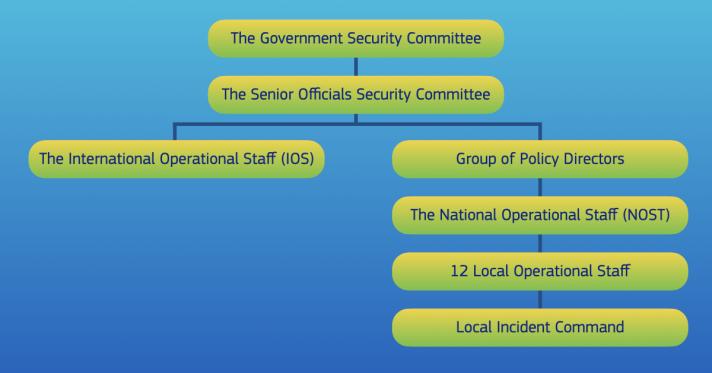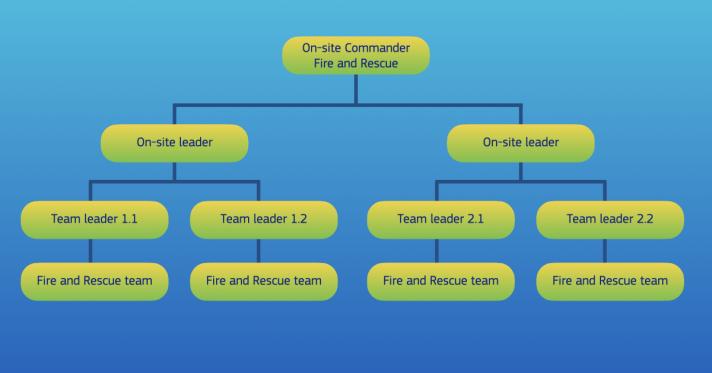
Overview
The national crisis management system ensures coordination at government level for incident response in Denmark and abroad. It consists of the following:
The national crisis management system is guided by 7 general principles stipulated in the National Emergency Plan. The principles are (i) sector responsibility, (ii) similarity, (iii) subsidiarity, (iv) cooperation, (v) precaution, (vi) flexibility, and (vii) direction.
The entities that make up the national crisis management system may be adjusted to any situational context, e.g., during the COVID-19 pandemic, the system was supplemented by the Group of Policy Directors.
Prevention
Overview
The Danish Emergency Management Act (DEMA) stipulates that, within their own areas, individual ministers must plan for the retention and continuation of functions in society in the event of accidents and disasters. Furthermore, they must also draw up emergency plans.
Each municipal and regional council must also prepare a plan for the emergency management of their municipality or region. The 32 municipal fire and rescue services in Denmark (owned by the 98 municipalities) must each maintain a plan based on local risks and conditions.
The Minister of Defence holds the responsibility – delegated to DEMA – to support the preparation of emergency plans by central government authorities, regions, municipalities, and municipal fire and rescue services. The Minister provides advice to the authorities, helps with planning, and coordinate guidelines.
At least once every 4 years, the plans must be revised and submitted to DEMA. Following the principle of sector responsibility, DEMA’s role is supervisory.
Risk assessment
The Danish national risk assessment (cf. the EU Civil Protection Mechanism article 6.1(a)) is carried out by DEMA in close consultation with other authorities and organisations every 4-5 years and published in a report called the National Risk Profile (NRP) report.
Risk management planning
Further to the Danish Emergency Management Act, responsibilities about risk management planning are also described in (i) the National Emergency Plan, (ii) the Comprehensive Preparedness Planning Guidelines, (iii) Guidelines for Crisis Management, (iv) Guidelines for On-scene Incident Command, among other plans, guidelines, and framework papers.
Moreover, other sector-specific legislation requires risk management planning for authorities and companies, e.g., in the health preparedness, transport and energy sectors.
Emphasis is predominantly on drawing up generic, all-hazards plans, i.e., focusing on the core tasks of crisis management irrespective of scenarios.
However, contingency plans for specific risks are also drawn up by and for members of the national crisis management system. The Nuclear Emergency Plan, as an example, is prepared by DEMA.
Risk communication and awareness raising
The principle of sector responsibility also extends to risk communication and awareness. For example, the sector responsible for an area involving a potential risk to the population has the responsibility to communicate about that risk under normal circumstances and in case of an emergency.
To communicate about and raise awareness of key risks, DEMA makes the National Risk Profile report available to the public and conducts a biennial survey on the public awareness of these risks.
The “Help-to-self-help” webpage has advice to citizens on countermeasures to key risks.
Data and research
DEMA generates a statistical overview of national fire- and rescue operations. The data-driven approach supports developments within the prevention, preparedness, and response cycle.
Furthermore, DEMA coordinates and researches topics such as green transportation and energy, fire probability analysis and mapping, wildfires, and prevention of work-related accidents among firefighters.
Preparedness
Training and exercises
DEMA offers a wide range of training courses. Their course catalogue includes courses for its own personnel as well as for personnel from other sectors.
The courses range from technical and operational courses (e.g., on-scene incident commanders) to more general courses about the national crisis management system, preparedness planning or crisis communication. They are primarily held at DEMA Emergency Services College.
Different exercises, such as tabletop exercises on procedures, dilemmas, crisis management or full-scale exercises, provide good training opportunities.
The national crisis management exercise series ‘KRISØV’, arranged biennially since 2003 by DEMA and the Danish National Police, is one such example. Regular exercises are also held within the NOST and the 12 local operational staff.
Early warning systems
Currently, Denmark’s automated early warning systems relate primarily to weather conditions and include different types of warnings, e.g., regarding driving conditions.
There is also an early warning system regarding projecting areas prone to extreme rainfall. However, this is only available to meteorologists. Warnings and alerts to the public are posted on the responsible authorities’ websites and apps.
In cooperation with the Danish Meteorological Institute (DMI) and the association “Danish Emergency Management Organisation”, DEMA also maintains a website for the municipalities and the public concerning the risk of fire in hot or dry seasons.
Furthermore, DEMA maintains a warning system for nuclear and radiological emergencies. The system consists of 11 automatic online measurement stations located across the country. In case of increased radiation from any sites, DEMA receives automatic alarms and can react.
Public warning systems
There is also a public warning system consisting of a nationwide siren system and a direct line to national broadcasters. The siren system is tested annually to raise awareness and test its functionality.
In addition, the hearing impaired are informed and alerted via an SMS alert service. Warnings are posted on the authorities’ social media and web platforms.
In 2023, Denmark will implement a mobile-based national warning system via cell broadcast technology. This enables the authorities to warn citizens and visitors with proper guidance.
Emergency Response
The Danish fire and rescue service consists of DEMA’s national fire and rescue service and the municipal fire and rescue service operated by employed staff and volunteers.
As of 2022, there are 32 municipal fire and rescue services in addition to DEMA’s 6 national fire and rescue centres. These centres have conscripts who trained during a 9-month service.
The municipal fire and rescue services are responsible for the first response. At the same time, DEMA assists at larger, longer-lasting or more complex incidents that may require specialised equipment or personnel.
DEMA has specialised Chemical, Biological, Radiological and Nuclear (CBRN) capacities and can assist and provide advice to authorities in case of an incident involving hazardous or unknown substances.
In case of a nuclear emergency, DEMA and the Danish Health Authority lead the response.
Cross-border, European and international cooperation
DEMA is the Danish contact point for international requests for emergency assistance and response to natural hazards or human-induced disasters.
It develops and maintains disaster response capabilities for international deployment and is actively involved in activities within the EU Civil Protection Mechanism, e.g., disaster response, training activities, exercises, etc., and as national training coordinator.
DEMA closely cooperates with other countries and organisations, e.g., the other Nordic countries, the UN, the International Humanitarian Partnership, and the Council of the Baltic Sea States Civil Protection Network.
In case Denmark should request assistance from other nations, DEMA, by the principle of sector responsibility, has prepared a set of procedures for host nation support that follow the EU’s HNS- guidelines.
Facts & figures
General contact point
brs brs [dot] dk (brs[at]brs[dot]dk)
brs [dot] dk (brs[at]brs[dot]dk)
Datavej 16, DK-3460 Birkerød
+45 7285 2000
Contact details to be used in case of emergencies
Phone number:112
Emergency 112 | | Danish police (politi.dk)
Contact the police | | Danish police (politi.dk)
Contact police district | | Danish police (politi.dk)
Contact point for international cooperation projects
brs-ktp-ibr brs [dot] fiin [dot] dk (brs-ktp-ibr[at]brs[dot]fiin[dot]dk)
brs [dot] fiin [dot] dk (brs-ktp-ibr[at]brs[dot]fiin[dot]dk)
+45 7285 2000
More information
The legal basis referred in the ‘Overview’ section
Organisational chart Danish Emergency Management Agency
List of bilateral and regional agreements on civil protection
National Risk Profile for Denmark (NRP)
Percentage of professionals and volunteers in emergency services:
|
|
2018 |
2019 |
2020 |
2021 |
|---|---|---|---|---|
|
Quantity |
|
|
|
|
|
Employment status |
6.557 |
6.542 |
6.450 |
6.559 |
|
Full-time |
1.364 |
1.366 |
1.350 |
1.399 |
|
Part-time |
4.031 |
4.017 |
3.959 |
4.035 |
|
Volunteer fire brigade association |
1.162 |
1.159 |
1.141 |
1.125 |
Source: Redningsberedskabet i tal 2021
Related pages
Last updated: 30/01/2023


